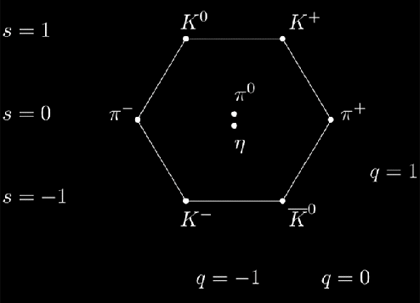
Mesons
Image: the meson octet. Those on the same horizontal line share the same strangeness (S), while those on the diagonals from top left to bottom right share the same charge (q).
Mesons are hadrons composed of one quark and one antiquark, bound together by the strong nuclear force (described by quantum chromodynamics or QCD). As a result they have integral spin and are therefore bosons. They may or may not be charged. For each meson there is an anti-meson.
All mesons are unstable, the lightest and longest-lived lasting only tens of nanoseconds. Since composite structures they are not pointlike, but have a radius comparable to that of a proton or neutron (about 10-15 metres). They participate through particle exchanges in both weak and strong nuclear forces. Since they are lighter than baryons (particles composed of three quarks with half-integral spin) they are produced in abundance in particle accelerators.
Massive bosonic particles were predicted by Yukawa in 1934 as the carrier of the strong nuclear force, the quanta of a scalar field theory satisfying the Klein-Gordon equation. The mu meson or muon was subsequently discovered by Carl Anderson in cosmic rays in 1936; it was named after Yukawa’s particle. However, the muon was eventually determined to be a massive partner to the electron. The first true meson to be experimentally detected was the pion, discovered in 1947 in cosmic rays by Cecil Powell, César Lattes, and Giuseppe Occhialini at the University of Bristol. With this confirmation of his prediction, Yukawa was awarded the Nobel Prize for Physics in 1949.
Links
Table of mesons and their properties >

